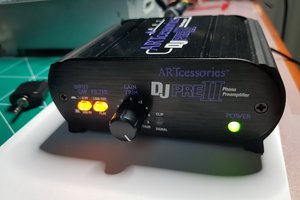(focus all photos/renders into the basic gallery)
(YouTube demo here)
Please Help
I like where xctr has come since it started, but eh, it's not quite good yet.
I seriously ask anyone, with even the slightest interest on xctr, to leave a little feedback, idea, or criticism. Thanks!
Exciters
Distributed Mode Speakers - Wikipedia
Exciters and Tactile Transducers 101 - Parts Express
An 'exciter' is a type of audio transducer device - the likes of speakers and tactile conduction devices.
The characteristic difference versus a normal speaker cone is that exciters attach onto an external surface that effectively function as a sound board, greatly increasing the loudness and frequency range even compared to a normal, diaphragm-based speaker with similar power capacity.
The combined system is referred to as 'distributed mode loudspeaker'.
DAEX30HESF-4
This is the exciter used for xctr. Fast specs: 40 W peak, 32 W RMS, 20 Hz to 20 kHz, 4 ohm resistance, more here.
40 W may sound a little low, but distributed mode loudspeakers tend to push out big volumes for given wattage.
The output volume, especially on DAEX30HSEF (a high-efficiency variant) will be rather quite loud.
Cardboard?
Just for a moment, I will rant about how amazingly great cardboard is. Look at this, this, this. Convinced?
Design
(written design)
<div style="max-width: 800px; max-height: 450px;"> <div style="left: 0px; width: 100%; height: 0px; position: relative; padding-bottom: 56.25%; overflow: hidden;"> <iframe src="untitled_XR.47.html" allowfullscreen style="position: absolute; top: 0px; left: 0px; height: 100%; width: 1px; min-width: 100%; *width: 100%;" frameborder="0" scrolling="no"> </iframe> </div>
</div>
I wanted the speaker to be made of two panels sandwiching a hollow section that contains the electronics. I was concerned about the method of attaching the panels to the speaker's body, as anything intrusive/aggressive will mess with its acoustic properties and possibly introduce resonance, as well as transferring the vibration to the floor. The more isolated and free it is, the better acoustics (I think).
(sketch)
(blender)
(cad)
(prototype)
Results
(YouTube video)
I am personally intending to use it as an electric guitar cabinet, connected to my guitar through USB ADC interface and AmpliTube 4 software.
One of the core weaknesses of surface transducer loudspeakers is the weak reproduction of bass frequencies (sub-150 Hz).
(frequency response table for the exciter model I'm using)
I also attached the written notes I've taken watching the two Tech Ingredient videos as well as Dayton Audio datasheets in the files section.
 Jason Cho
Jason Cho

 Ivano Pelicella
Ivano Pelicella
 Frank Piesik
Frank Piesik
 Sam Pullman
Sam Pullman
 Jovan
Jovan
실제 프로젝트가 없는게 문제